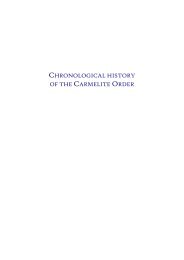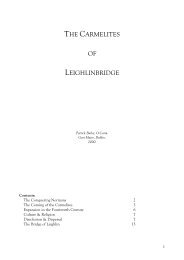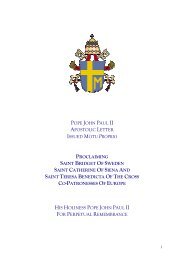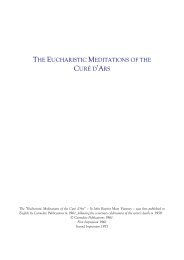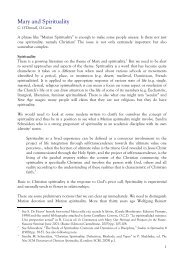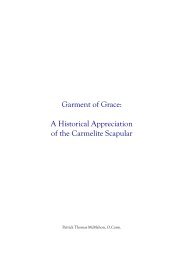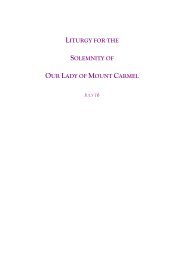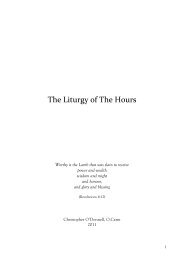The Diocese of Mutare & The Carmelites in Zimbabwe - the Irish ...
The Diocese of Mutare & The Carmelites in Zimbabwe - the Irish ...
The Diocese of Mutare & The Carmelites in Zimbabwe - the Irish ...
Create successful ePaper yourself
Turn your PDF publications into a flip-book with our unique Google optimized e-Paper software.
<strong>The</strong> policy <strong>of</strong> <strong>the</strong> Jesuits which was later <strong>in</strong>herited by <strong>the</strong> <strong>Carmelites</strong> was to concentrate on <strong>the</strong> central mission<br />
and <strong>the</strong> people were obliged to go to <strong>the</strong> Mission for all <strong>the</strong>ir requirements. This <strong>of</strong>ten <strong>in</strong>volved walk<strong>in</strong>g for great<br />
distances. Aga<strong>in</strong> <strong>the</strong> ma<strong>in</strong> concentration was on religion to <strong>the</strong> neglect <strong>of</strong> land-husbandry, domestic science, child<br />
care etc. O<strong>the</strong>r missionary bodies like <strong>the</strong> Methodists went <strong>in</strong> for <strong>the</strong> evangelization <strong>of</strong> <strong>the</strong> whole person.<br />
Sa<strong>in</strong>t Barbara’s Mission: First Mass 1910. Officially established 1927.<br />
o <strong>The</strong> present Sa<strong>in</strong>t ‘Barbara’s Mission area’ was an out-station <strong>of</strong> Triashill Mission.<br />
o <strong>The</strong> first Mass was said <strong>in</strong> <strong>the</strong> area on Easter Monday, 1910.<br />
o <strong>The</strong> ‘Mission’ started to develop dur<strong>in</strong>g 1913 and <strong>the</strong> development cont<strong>in</strong>ued until 1927. <strong>The</strong> Mission<br />
was ‘<strong>of</strong>ficially established’ dur<strong>in</strong>g 1927.<br />
o <strong>The</strong> present Church was built dur<strong>in</strong>g 1931.<br />
o Like Triashill Mission, <strong>the</strong> Mariannhill Fa<strong>the</strong>rs and Bro<strong>the</strong>rs m<strong>in</strong>istered at Sa<strong>in</strong>t Barbara’s Mission,<br />
followed by <strong>the</strong> Jesuits. <strong>The</strong> <strong>Carmelites</strong> followed <strong>the</strong> Jesuits and were entrusted with <strong>the</strong> Mission between<br />
1948 and 1950<br />
<strong>The</strong> land around Sa<strong>in</strong>t Barbara’s Mission was very fertile and flat and a few hundred acres were reserved for <strong>the</strong><br />
use <strong>of</strong> <strong>the</strong> Missionaries. When Ambrose Majongwe was at school <strong>in</strong> Triashill, he and his companions were asked<br />
to walk to St. Barbara’s to till <strong>the</strong> fields and do general chores. Apparently <strong>the</strong> missionaries got tired <strong>of</strong> <strong>the</strong> 16<br />
mile trek and decided to rema<strong>in</strong> around St. Barbara’s area <strong>in</strong> order to supervise <strong>the</strong>ir tillage and so St. Barbara’s<br />
Mission was founded <strong>in</strong> 1927, perhaps founded out <strong>of</strong> convenience due to <strong>the</strong> miles <strong>of</strong> trek to and from Triashill.<br />
Dur<strong>in</strong>g <strong>the</strong> previous year, 1926, three aspirants came forward for <strong>the</strong> priesthood, <strong>the</strong>re were A. Majongwe, M.<br />
Sedze and K. Samukandi. Kilian Samukandi was eventually orda<strong>in</strong>ed to <strong>the</strong> priesthood and m<strong>in</strong>istered <strong>in</strong> South<br />
Africa. Ambrose Majongwe, ex MP, MBE, decorated by Pope Pius X11 was murdered dur<strong>in</strong>g 1978.<br />
When <strong>the</strong> Jesuits came to take over St. Barbara’s Mission <strong>the</strong>y did not spare <strong>the</strong>mselves <strong>in</strong> <strong>the</strong> build<strong>in</strong>g <strong>of</strong> <strong>the</strong><br />
mission which could be regarded for that particular time as a masterpiece. <strong>The</strong>re was a well constructed church<br />
with a magnificent convent for <strong>the</strong> Sisters at <strong>the</strong> side <strong>of</strong> <strong>the</strong> Church. Unfortunately <strong>the</strong> Jesuits at that time were<br />
unaware <strong>of</strong> ant courses or any o<strong>the</strong>r form <strong>of</strong> ant deterrent and dur<strong>in</strong>g <strong>the</strong> follow<strong>in</strong>g years, <strong>the</strong> ants simply played<br />
havoc with <strong>the</strong> mission despite <strong>the</strong> well structured build<strong>in</strong>gs. <strong>The</strong> orig<strong>in</strong>al plan was to build a presbytery on <strong>the</strong><br />
o<strong>the</strong>r side <strong>of</strong> <strong>the</strong> church but <strong>the</strong>y never got around to it and <strong>the</strong> missionaries lived <strong>in</strong> ano<strong>the</strong>r build<strong>in</strong>g nearby.<br />
When <strong>the</strong> mission was taken over by <strong>the</strong> <strong>Carmelites</strong>, Fr A. Corbett became <strong>the</strong> priest <strong>in</strong> charge. In time, Fr A.<br />
Corbett ga<strong>in</strong>ed a great command <strong>of</strong> <strong>the</strong> Shona language after learn<strong>in</strong>g <strong>the</strong> language at Mhondoro with Fr. L.<br />
Flynn. Fr. M. Aherne and Bro<strong>the</strong>r Bernard Cl<strong>in</strong>ch jo<strong>in</strong>ed <strong>the</strong> community at St. Barbara's. <strong>The</strong>re were three<br />
communities <strong>of</strong> Sisters also, namely <strong>the</strong> Precious Blood Sisters, <strong>the</strong> Tr<strong>in</strong>ity Sisters and <strong>the</strong> LCBL Sisters. <strong>The</strong>re<br />
was a hospital, an orphanage, a very well arranged farm and farmyard at St. Barbara’s at that time. Up to<br />
1948, <strong>the</strong> gr<strong>in</strong>d<strong>in</strong>g <strong>of</strong> maize was done at Triashill and a big ox-wagon, pulled by eight oxen made <strong>the</strong> weekly<br />
journey to and from Triashill with maize and upfu, which is ‘ground maize’.<br />
As St. Barbara’s was on <strong>the</strong> border <strong>of</strong> <strong>the</strong> Makoni and Manica communal lands <strong>the</strong>re existed a number <strong>of</strong><br />
outstations or outschools. It was <strong>the</strong> custom that one priest rema<strong>in</strong>ed on <strong>the</strong> mission, generally <strong>the</strong> priest <strong>in</strong> charge<br />
who looked after <strong>the</strong> mission and school while ano<strong>the</strong>r priest acted as ‘super<strong>in</strong>tendent <strong>of</strong> <strong>the</strong> outschools’. As time<br />
went on this arrangement gave a very bad impression as missionaries were regarded as civil servants. St. Barbara’s<br />
had some <strong>of</strong> <strong>the</strong> f<strong>in</strong>est outschools <strong>in</strong> <strong>the</strong> area such as Bethania, Loretto and St. Anna’s which was later to become<br />
St. Columba’s Mission <strong>in</strong> <strong>the</strong> Honde Valley. Fa<strong>the</strong>r Schmitz, S.J. was <strong>the</strong> last Jesuit to serve at St. Barbara’s<br />
Mission.<br />
<strong>The</strong> <strong>Carmelites</strong> became very <strong>in</strong>volved <strong>in</strong> education <strong>in</strong> <strong>the</strong>ir mission areas possibly because many had University<br />
Degrees and were eligible for salaries whereas <strong>the</strong> wages <strong>of</strong> <strong>the</strong> African teachers <strong>in</strong> schools was hopelessly and<br />
unjustifiably low.<br />
11




